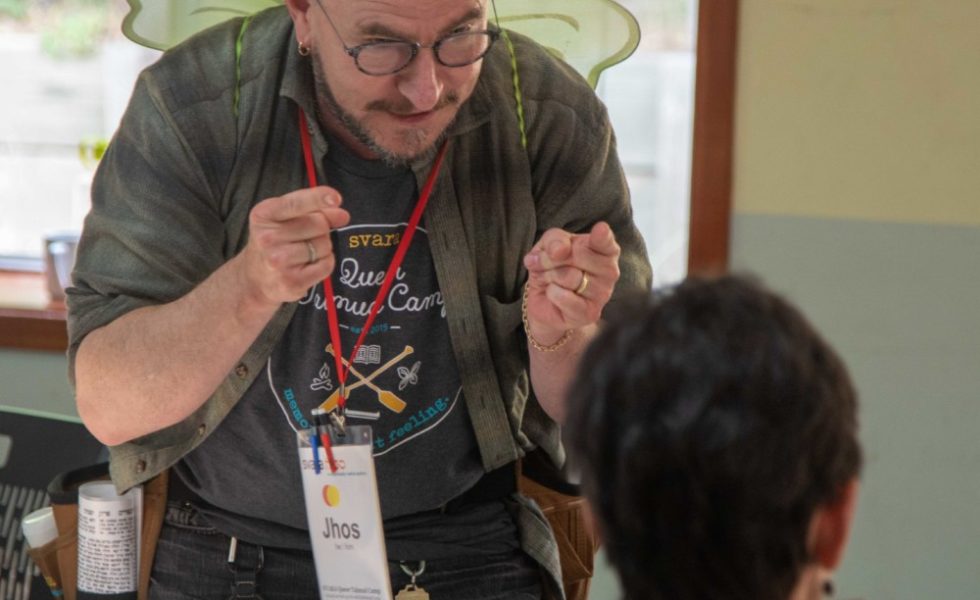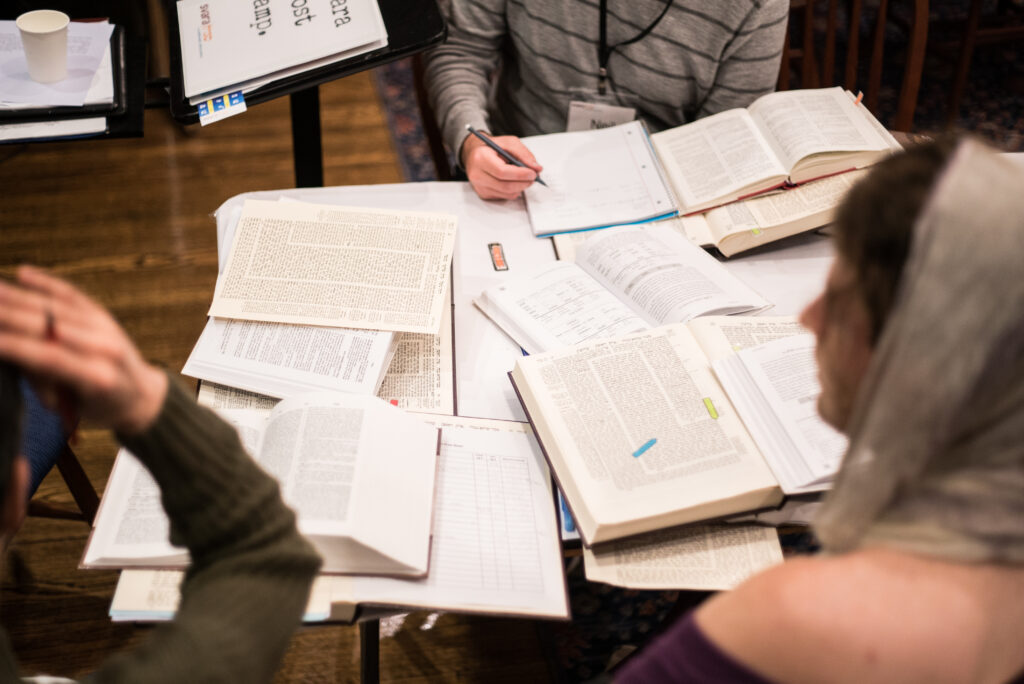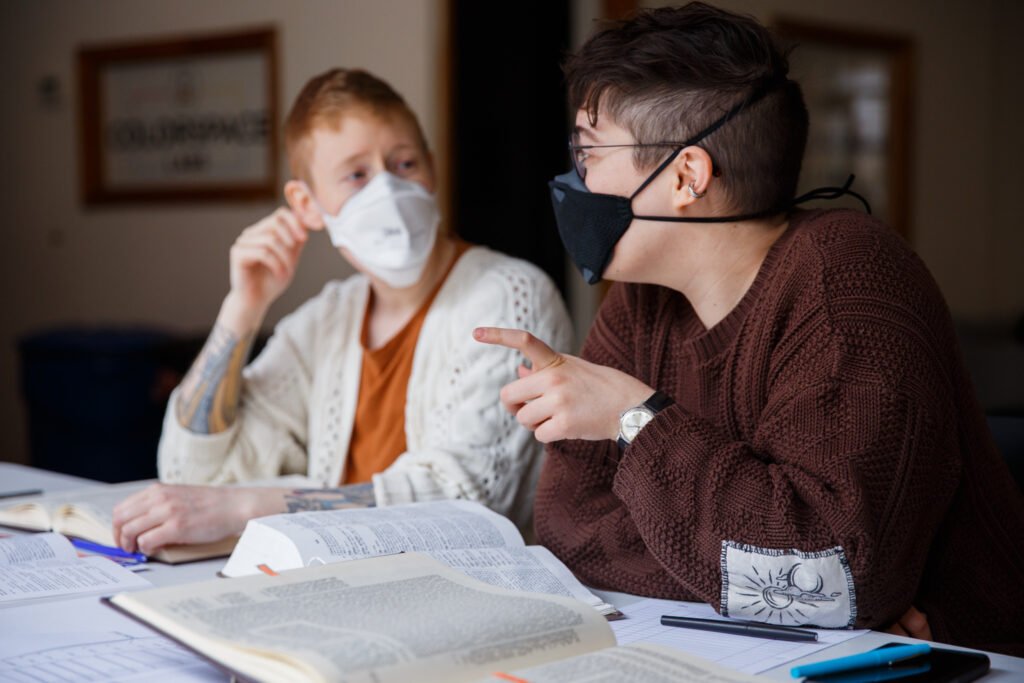I’ve been studying with SVARA for a long time—25.806% of my life, to be precise—and for much of that time I was a stalwart grammarphobe. Until one day, in 2016, my face buried in a masechet under the oaks at Queer Talmud Camp, I finally grokked that diacritical dots, dashes, and signal letters are whetstones not stumbling blocks. I suddenly understood why at SVARA we teach, “Learn what the words mean, but equally, learn how each word means what it means.” After years of withholding, I’ve gingerly embraced the mechanisms that shape and tool Hebrew. How prefixes, suffixes, infixes and circumfixes reveal unique and tightly focused ideas encoded in each word root. I now marvel that I resisted forging such intimacy with each word. But before this epiphany, I was impatient, would cut to the chase, push past the skin to get to the bones of content. Why waste time dissecting every word, quibbling over pronunciation, hunting down irregular patterns? Let’s get to the grand ideas, the relevance to our lives, the insight and wisdom! I wanted to discuss a topic, not parse whether we were dealing with a participle or a noun. I was in hot pursuit of the drash.
Drash/Interpretation is my wheelhouse. Give me line of Torah or Talmud and I will happily silly-putty it all day—stretching and pulling the pshat (simple meaning—ie “and Moses spoke”= Moses said something) into drashot (So the phrase “and Moses spoke” repeatedly affirms the spiritual power of the wound—Where Moses was most vulnerable, speech, is found the channel through which he leads, inspires, challenges, fumbles, and eventually transforms….). From a pedestrian line of Torah to a hyperbolic and outlandish Talmudic proclamation, I’m in my element when puzzling out where they connect to us, now. The Talmud asks, “Can a tethered elephant serve as a sukkah wall? And if so, and it dies, is the wall still acceptable?” Instantly I’m imagining that the sukkah represents America’s inequitable society. What happens to white supremacy, racism, and economic injustice when the elephant dies? How do we face and prepare for the imminent, inevitable, and necessary collapse of a deplorable and integral part of our culture? Who will clean up the mess and rebuild the world anew? Whoever thought a tethered elephant was a suitable building material? What possessed those who tethered the elephant in the first place? I could always pull a nugget out of a big picture, but I froze when confronted with the granular nature of the language itself.
I am forever grateful for my beloved teacher, our Rosh Yeshiva, the one and only R”BeL* for keeping me in the fold. She overlooked my linguistic shortcomings year after year, while lovingly, incessantly, and encouragingly nudging me closer to the nuts and bolts of “inside translation”. Though I persisted in the warm shallows of outside interpretation, Benay never gave up—and I am grateful for that undying support. Eventually I recognized that to own this material and crack the deepest codes of meaning I would need to confront those pesky linguistic details where all is revealed. This came into sharp focus when I studied BT Sanhedrin 68b wherein the rabbis grapple with the Torah’s instructions of what to do with a rebellious and stubborn son, which, famously, ends with a crowd stoning him to death (Deuteronomy 21:18). Impishly, the sages deconstruct nearly every word in this Torah passage. They deftly leverage the irregular syntax and grammar to spin the meaning. Simultaneously, they apply a hyper-literal lens to the text through which they prove that, in fact, contrary to popular belief, the passage says that under no circumstance whatsoever should a child be given the death penalty for being rebellious and belligerent. And just to make sure there is no mistake the Talmud repeatedly states:
“A rebellious and stubborn son? There never was, or will be, one.” “So why was this line of Torah written?” “So you can drash, investigate, interpret, and expound on it and receive reward.” (BT Sanhedrin 71a)
I was like, “WHAAAAATTTT!!!??!! How did they pull THAT off??” I was blown away and suddenly hungry to learn what I had avoided all those years. Binyanim replete with verb tenses and conjugation tables, nikudot revealing the exact pronunciation, and signal letters became coveted tools. With them, I could drash even more, even better!! I saw the power in linguistic precision, the details became relevant. I found myself getting very cozy with “Grammar for Gemara” which had rested for years on my shelf of purchased but rarely opened Hebrew and Aramaic grammar books. I was all in, ready to use my newly gained interpretive tools to plunder the text for new treasure. With work, the patterns started to gel, the grammatical structure to make sense. I turned a corner I had actively avoided for many years, just like that.
Recently I’ve wondered, why was I so resistant to learning these fundamental skills? I’m usually an enthusiastic and compliant student, so what was it about the mechanics of Hebrew that felt so off-putting? Why did I glaze over every time the focus shifted from the sentence to the individual words? What was going on that kept me from maximizing my learning?
Oddly, I had an insight about this resistance in the shower recently. I noticed a slight swelling in my left foot. Oh, and there was that funny bump on my left thumb that showed up recently. Also, a dry and irritated spot on my left cheek. Hmmmm…. all on the left side…coincidence? I wonder… Being unclad I scanned other parts of myself, looking for any other corporeal curiosities. Immediately after drying and dressing, I shot off yet another report with these findings to my poor beleaguered doctor, who always greets these missives warmly, calmly, and with concern. (And, good news, I’m fine.) Then it hit me: details, precision, noticing every little thing on this body? Taking its messages seriously? Not avoiding or ignoring the details of my physical self? That was not always the case. Uh-oh, I feel a drash coming on….
Seventeen years ago, I began a long overdue remodeling project on my spiritual house. At 45 I started lobbing gobs of testosterone into a middle-aged female body, and thus catalyzed adolescence 2.0. Just as happens to a cis guy when he is also quenched in hormones, my vocal cords thickened, muscles strengthened, fat moved around, facial hair sprouted, bones reshaped, and familiar scents changed. I was totally in tune with the shifting landscape of my back and legs, my arms and face. My response to these changes was a total reversal of my first shot plunge down the puberty chute. As a teenager I instinctively ignored the way my androgynous childhood body feminized without my consent. As curves formed and fertility initiated its monthly grind, a chasm grew between my soul and corporeal self. As long as my body functioned well enough to house my spirit, I was good to go. I actively ignored any details of my body’s maturation beyond the scope of health and hygiene. It was in my psyche’s best interest to find meaning in the whole, while maintaining a healthy distance from the precise features. I accepted and embraced the umbrella appellation “human being”. But the morphology, the dots and dashes defining the structure of my body, the aspects that sharpened, narrowed, and precisely marked me as a feminine noun—these I pushed aside. However, try as I might, looking away didn’t quell the deep and nagging feeling that my sense of self was incomplete. I skittered by like that for a while. Eventually it became glaringly clear that those niggling details are there for a reason, and ignoring them can lead to depression, illness, and routinely making bad life decisions.
And so, reluctantly, terrified, and utterly uncertain, I began to transition. Quickly I found myself in the throes of adolescence complete with a whole host of biochemical bells and whistles tweeting and clanging to beat the band. But this time, instead of turning away, I looked. I noticed my voice’s timbre darkening, my skin erupting. I marveled at how easy it was to move large boxes packed with books, was shocked to experience tender parts of me tingling uncontrollably at inopportune times, and I carefully tracked the progress of the downy fuzz appearing on my face. My body’s changes were welcome, affirming, and empowering. Each physical detail taking shape was informative, illuminating, and important. I was finally growing up, celebrating my whole truth, and most surprisingly, discovering a delightful connection between the precision of my body and the vagaries of my soul. I was coming into alignment, my male and female aspects reorienting into better balance, harmony, and peace; my spiritual and physical selves integrating easily. Finally, the Divine was in the details.
The body, like the Talmud, can be treated as a repository, a container, a vessel. Each are filled to the brim with stories and laws, memories, and truth. And for a time, a crate, brown paper bag, or banker’s box might do. But to really celebrate, own, and love ourselves and this tradition it behooves us to attend to the cables and rivets, bindings and adornments, gears and gaskets, doors and windows which house, shelter, and add meaning to the life we’ve been gifted. I am so grateful to SVARA for holding that space for me while I slowly made my way home. While I still, ultimately, privilege the wine over the bottle, while on this journey I have come to deeply appreciate the beauty, truth, and courage which flourish mightily when conferred in precisely designed, meticulously crafted, breath takingly beautiful decanters. And so, with delight and courage, let us interpret, investigate, examine, and expound on every crown and letter, marvel at every angle of our face and limbs, and let us receive dazzling reward.
*R(abbi) Be(nay) L(appe)







